Tinian
Tinian (/ˈtɪniən/ or /ˌtiːniˈɑːn/; old Japanese name: 天仁安島, Tenian-shima) is one of the three principal islands of the Commonwealth of the Northern Mariana Islands. Together with uninhabited neighbouring Aguigan, it forms Tinian Municipality, one of the four constituent municipalities of the Northern Marianas. Tinian's largest village is San Jose.
 Tinian on an area map, southwest of Saipan, showing waters around islands, and deeper Pacific section. | |
 | |
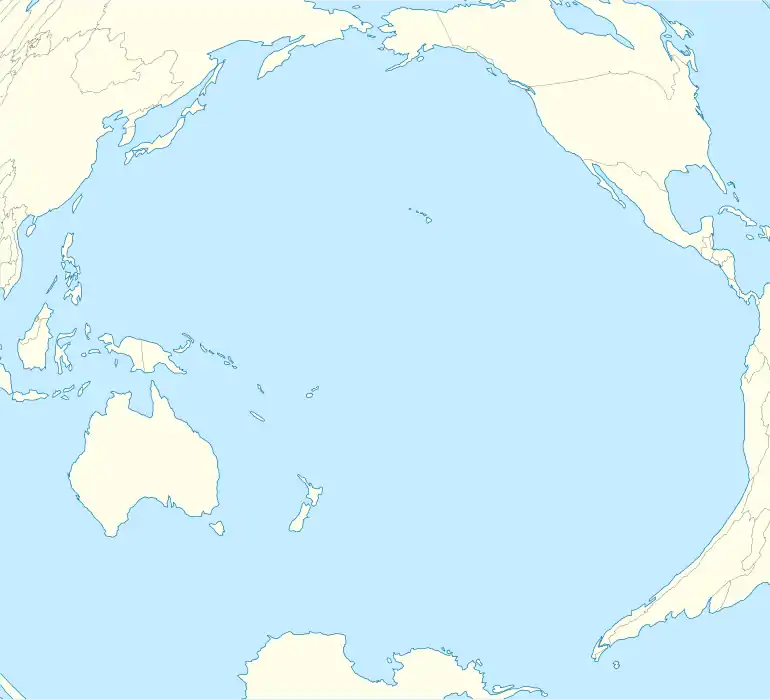 Tinian | |
| Geography | |
|---|---|
| Location | Pacific Ocean |
| Coordinates | 15°00′N 145°38′E |
| Archipelago | Marianas |
| Area | 101.22 km2 (39.08 sq mi)[1] |
| Highest elevation | 171 m (561 ft) |
| Highest point | Mount Lasso |
| Administration | |
United States | |
| Commonwealth | Northern Mariana Islands |
| Largest settlement | San Jose |
| Demographics | |
| Population | 3,136 (2010) |
History
Prehistory
Traces of human settlements on Tinian have been found by archaeologists ranging over 4,000 years in datings, including ancient latte stones, and other artifacts pointing to cultural affinities with Melanesia and with similar stone monuments in the Federated States of Micronesia and Palau. Around 3000 years ago, Tinian was ruled by the Chamorro Chief Taga, who built the biggest stone home with latte stones. A beach on Tinian (Taga Beach) and the local charter airline (Taga Air) were named after him.
Spanish colonial period
Tinian, together with Saipan, was possibly first sighted by Europeans of the Spanish expedition of Ferdinand Magellan, when it made landfall in the southern Marianas on 6 March 1521.[2] It was likely sighted next by Gonzalo Gómez de Espinosa in 1522 on board the Spanish ship Trinidad, in an attempt to reach Panama after the death of Magellan.[3] This would have happened after the sighting of the Maug Islands in between the end of August and end of September. Gonzalo de Vigo deserted in the Maugs from the Trinidad and in the next four years, living with the Chamorros, visited thirteen main islands in the Marianas and possibly Tinian among them.
The first clear evidence of European arrival was by the Manila galleon Santa Margarita commanded by Juan Martínez de Guillistegui, that wrecked in the southeast of Saipan in February 1600 and whose survivors stayed for two years till 250 were rescued by the Santo Tomas and the Jesus María.[4] The Spanish formally occupied Tinian in 1669, with the missionary expedition of Diego Luis de San Vitores who named it Buenavista Mariana (Goodsight Mariana). From 1670, it became a port of call for Spanish and occasional English, Dutch and French ships as a supply station for food and water.
The native population, estimated at 40,000 at the time of the Spanish arrival, shrank to less than 1400 due to European-introduced diseases and conflicts over land. The survivors were forcibly relocated to Guam in 1720 for better control and assimilation. Under Spanish rule, the island was developed into ranches for raising cattle and pigs, which were used to provision Spanish galleons en route to Mexico.
Lord Anson and The Centurion, 1742.
On 27th August 1742, Lord Anson, Captain of the English ship "Centurion", made landfall at Tinian.
He approached the island under false colours of the ruling, and currently enemy Spanish, believing the island might be garrisoned. This was a defensive measure, as the men of the Centurion were too weak and sick to even work the ship properly, let alone defend her against an enemy challenge. The Centurion was the flagship of Anson's original squadron of five men-of war, one sloop of war and two victualling ships which had left England on 18th September 1740 on an official government war mission: To harass, attack and plunder Spanish interests in South America and the Pacific, as the two countries were then at war.
The Centurion was now the one and only remaining ship of Anson's original squadron of eight ships.
Anson had some months earlier rounded Cape Horn with his squadron of ships, and then ranged up and down the east coast of South America on his appointed mission: To harass and plunder Spanish interests along that coast, and to intercept and capture the Spanish "Manilla Galleon", which was then predicted to be it's outward journey from Manilla in the Philippine Islands to Acapulco in South America. Anson's squadron was able to intercept some Spanish shipping along the coast of South America, and also landed and temporarily occupied a few small Spanish settlements, but he missed intercepting the all important Manilla Galleon at that time, either on its outward journey from Manilla, or its treasure-laden return to Manilla from South America.
After remaining at sea at various intercept stations for many weeks, Anson finally decided to head across the Pacific Ocean to Macao to resupply and refit the remaining two ships of his original squadron, the "Centurion" and the "Gloucester", before the adverse monsoon season set in. He would then head back to England via the Cape of Good Hope.
In their westward crossing of the Pacific, they met with raging storms, becalming, thirst, hunger, sickness, injury and daily death. The "Gloucester" had to be abandoned and scuttled at sea, due to storm damage and leaks. Her crew were saved and transferred aboard the Centurion.
The Centurion, Anson's last surviving ship, was by now in a terrible state. It was leaking badly, heavily storm damaged and overcrowded with very weak, sick and dying men, (many taken from the Gloucester); along with several remaining captives from earlier intercepts of enemy Spanish ships along the east coast of South America.
Then in the offing, came the small island of Tinian. Tinian saved their lives.
This island was like a miracle of salvation for these men. Anson found Tinian to be an exceptionally beautiful garden island. It was a true paradise of safety and plenty for hungry, weak, very sick and dying sailors, such as they all were at that critical time.
Tinian was lush and fertile. They found it covered with meadows of green grass and groves of trees. The land abounded in healthy cattle, chickens, citrus and other fruits, coconuts and vegetables. However, Anson also found Tinian lacked any streams of fresh, running water that he could find. But ample rainfall and good natural drainage kept everything on the island fresh, lush and plentiful. Anson found Tinian to be entirely unpopulated, except for a small group of local people sent temporarily to the island by the Spanish authorities in Guam, for the purpose of gathering fruits, meat and vegetables from Tinian, for supply of the population on Guam, and for servicing the all important Manilla Galleons.
Fortunately for them, with plentiful, good food and fresh water, Anson and his men fairly quickly recovered their health on the garden paradise of Tinian (mainly from the disease of scurvy). After the Centurion had been twice blown out to sea by raging storms, with only a skeleton crew on board and losing all but one anchor, Anson and his now relatively healthy crew departed Tinian for Macao, on 21st October 1742.
Finally, after earlier refreshing and repairing the Centurion in Macao, on 20th June 1743 off Cape Espiritu Santo, Anson and his crew intercepted and captured the treasure-laden Manilla Galleon "Nostra Signora del Cabadonga" on her return from Acapulco to Manilla. The treasure she carried was 1,313,843 pieces of eight and 35,682 oz. of virgin silver. Anson's overall treasure prizes from all captures on his 4 year mission, including the Manilla Galleon amounted to around £400,000 in 1743 terms. A fabulous sum in today's money.
Refer to the book:"A Voyage Round the World 1740-4 by Lord Anson"... "Compiled from Papers and other Materials of the Right Honourable GEORGE Lord ANSON, and published under his Direction by Richard Walter, Chaplain of the Centurion on that voyage."
German colonial period
After the Spanish–American War of 1898, Tinian was occupied by the US. It was later sold by Spain to the German Empire in 1899. The island was administered by Germany as part of German New Guinea. During the German period, there was no attempt to develop or settle the island, which remained under the control of its Spanish and mestizo landowners.
Japanese colonial period
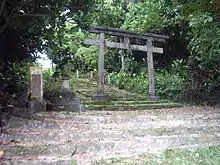
In 1914, during World War I, the island was captured by Japan, which was awarded formal control in 1918 by the League of Nations as part of the South Seas Mandate. The island was settled by ethnic Japanese, Koreans and Okinawans, who developed large-scale sugar plantations.[5] Under Japanese rule, extensive infrastructure development occurred, including the construction of port facilities, waterworks, power stations, paved roads and schools, along with entertainment facilities and Shinto shrines. Initial efforts to settle the island met with difficulties, including an infestation of scale insects, followed by a severe drought in 1919.
Efforts were resumed under the aegis of the Nanyo Kohatsu Kabushiki Kaisha in 1926, with new settlers from Okinawa as well as Fukushima and Yamagata Prefectures, and the introduction of coffee and cotton as cash crops in addition to sugar, and the construction of a Katsuobushi processing plant. By June 1944, some 15,700 Japanese civilians resided on Tinian (including 2700 ethnic Koreans and 22 ethnic Chamorro).
World War II

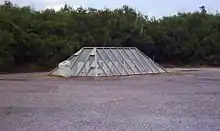
Tinian was not garrisoned by the Japanese military until the latter stages of World War II, when the Japanese realized its strategic importance as a possible base for American Boeing B-29 Superfortress bombers. The island was seized by the Allies during the Battle of Tinian from 24 July to 1 August 1944. Of the 8,500-man Japanese garrison, 313 survived the battle. At the time, there were an estimated 15,700 Japanese civilians (including 2700 ethnic Koreans) on the island. Many hundreds were also killed in the crossfire, took their own lives, or were executed by the Japanese military to avoid capture by the Americans.[6]
Tinian is located approximately 1,500 miles (2,400 kilometres) from mainland Japan, and was suitable as a staging base for continuous heavy bomber attacks on the Japanese Islands. Immediately after the island's seizure by the US, construction began on the largest airbase of WWII, which covered the entire island (except its three highland areas). The base was a 40,000-personnel installation, and the Navy Seabees (110th NCB) laid out the base in a pattern of city streets resembling New York City's Manhattan Island, and named the streets accordingly.
The former Japanese town of Sunharon was nicknamed "The Village" because its location corresponded to that of Greenwich Village. A large square area between West and North Fields, used primarily for the location of the base hospitals and otherwise left undeveloped, was called Central Park.[7]
Two runway complexes, West Field and North Field, having a combined total of six 8,500-foot (2,600-meter) runways, were constructed. Today the four runways at North Field are overgrown and abandoned. One of the two West Field runways remains in use as part of Tinian International Airport.[8]
West Field
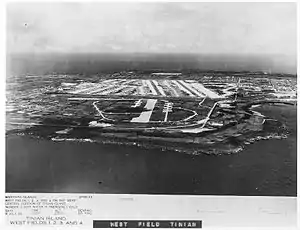
Airfield construction was originally by the Japanese, built with two parallel runways. It was repaired by the Americans, and then called West Field.[9] From here seven squadrons of the 58th Bombardment Wing flew combat and reconnaissance missions throughout Southeast Asia and finally into the Japanese home islands, as part of the bombing of Japan.[9][10]
After WWII, West Field was Tinian's airport called Gurguan Point Airfield;[9] and today is Tinian International Airport.
North Field
The Japanese had constructed three small fighter strips[5] on Tinian, but none were suitable for bomber operations. Under the Americans, nearly the entire northern end of the island was occupied by the runways, almost 11 miles (18 km) of taxiways and the airfield area, designed to accommodate the entire 313th Bombardment Wing complement of Boeing B-29 Superfortress bombers.[5]
North Field was the departure point of the 509th Composite Group specialized Silverplate nuclear weapons delivery B-29 bombers Enola Gay and Bockscar, which respectively carried the two atomic bombs named Little Boy and Fat Man, that were dropped on Hiroshima and Nagasaki.[8]
Remains of the US bomber base and Atom Bomb Pits,[8] and the remains of Japanese fortifications, are located at North Field. There is a memorial on the old airfield at the loading pits, which are roofed-over with glazed panels in metal framing for safer viewing. Both pits were reopened in conjunction with the 60th Anniversary Commemoration of the Battles of Saipan and Tinian. The pits were originally constructed to load the bombs, since they were too large to be loaded in the conventional manner. The B-29s were maneuvered over a pit with their bomb bay doors open to facilitate loading.[11]
Postwar Tinian
After the end of World War II, Tinian became part of the Trust Territory of the Pacific Islands, controlled by the United States. The island continued to be dominated by the United States military, and until 1962 was administered as a sub-district of Saipan. Since 1978, the island has been a municipality of the Commonwealth of the Northern Mariana Islands.
During the 1980s, one of the runways on North Field was kept active to allow U.S. Air Force C-130s to take off and land in support of U.S. Marine Corps training exercises in the north end of the island. The two northern airstrips, Alpha and Bravo, were cleared of vegetation and the limestone coral that had been disturbed by roots was excavated and replaced by Marines of the 9th Engineer Support Battalion, 3rd FSSG, 3rd Marine Division then stationed at Camp Hansen, Okinawa in late 1981. That unit had been transported by sea aboard the USS Cayuga, LST-1186.[12] The military presence began to be replaced by tourism in the 1990s, but still plays an important role in the local economy.
On October 24, 2018, Typhoon Yutu made landfall on the island of Tinian as a Category 5-equivalent super typhoon, becoming the most powerful storm on record to hit the Northern Mariana Islands, and causing an extensive amount of damage.[13][14]
Geography
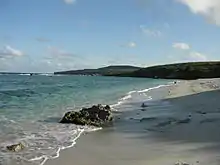
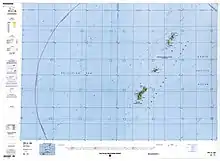
Tinian is about 5 nautical miles (9.3 km) southwest of Saipan, from which it is separated by the Saipan Channel. It has a land area of 39 square miles (100 km2), with its highest elevation at Mount Lasso at 171 meters (561 ft).
The island has a variety of flora and fauna, and limestone cliffs and caves. The Tinian monarch is the island's only endemic bird species and it is threatened by habitat loss. There is a variety of marine life and coral reefs surrounding the island. Its clear, warm waters are ideal for snorkeling, scuba diving and sport fishing.
Population
The population of Tinian was 3,136 (as of 2010), which corresponds to less than 5% of all residents of the Northern Mariana Islands and a population density of 31 people per km2. Most of the inhabitants are Chamorros (about 75%) and members of various other groups of islands in the Caroline Islands. There are also minorities of Filipino, Bangladeshi, East Asian and European-descended people.
Economy
Much of the local economy of Tinian is dependent on tourism, however, tourist infrastructure is relatively poorly developed. The village of San Jose has several smaller hotels, restaurants, and bars. Agriculture is primarily on the subsistence level. The largest employers on the island are the government and the casino, which was legalized in 1989. As of March 2006, the island has plans to put in four new casinos. The 2010 census showed a population of 3,136[15] for the island.[16]
Transportation
Air
Tinian Airport is small and serviced by Star Marianas Air, which operates daily scheduled flights to Saipan. Freedom Air, who previously served the island filed for bankruptcy in October 2013 and suspended all operations since March 2014.
Ferry
The ferry boat service that operated twice daily between Tinian and Saipan ran at a loss estimated to be US$1 million a year, and has since ceased.
Government
The local government is the Municipality of Tinian and Aguiguan, which also includes the uninhabited island Aguijan.[17] The municipality has a land area of 108.1 km2 (41.738 sq mi). The 2000 census population was 3,540 persons, all living on the island of Tinian (Aguijan is uninhabited). The municipal seat and main village of the island of Tinian is San Jose, situated on the southwest coast.[18] Mayor Edwin P. Aldan was inaugurated in January 2019,[19] succeeding Joey San Nicolas.
Local attractions
House of Taga

The House of Taga is a latte stone site, one of the largest such structures in the Marianas. The stones are quarried limestone, each approximately 20 feet (6.1 m) in length. Of the twelve large Latte structures, only one is still standing. The site is one of seven locations on Tinian on the National Register of Historic Places listings in the Northern Mariana Islands.
Education
Commonwealth of the Northern Mariana Islands Public School System operates public schools including Tinian Elementary School,[20] and Tinian Jr./Sr. High School.
State Library of the Commonwealth of the Northern Mariana Islands operates the Tinian Public Library in San Jose Village.[21]
References
- "7 TINIAN" (PDF). National Oceanic and Atmospheric Administration. p. 2. Archived (PDF) from the original on 15 November 2020. Retrieved 15 November 2020.
- Rogers, Robert F.; Ballendorf, Dirk Anthony (1989). "Magellan's Landfall in the Mariana Islands". The Journal of Pacific History. Taylor & Francis Ltd. 24 (2): 198. doi:10.1080/00223348908572614.
- Brand, Donald D. The Pacific Basin: A History of its Geographical Explorations The American Geographical Society, New York, 1967, p.118.
- Sharp, Andrew (1960). The discovery of the Pacific Islands. Oxford: Clarendon Press.
- "Pacifics Wrecks: Tinian History". Archived from the original on 8 May 2006. Retrieved 10 April 2006.
- Prefer, Nathan N. The Battle for Tinian: Vital Stepping Stone in America's War Against Japan. Havertown, PA: Casemate Publishers, 2012. ISBN 978-1-61200-107-4. pp. 155–156.
- Carlson, Jen (29 July 2015). "These NYC Streets Are Located In The Middle Of The Pacific Ocean". Gothamist. Archived from the original on 19 November 2015. Retrieved 6 December 2015.
- "Pacific Wrecks: Ushi North Field". Archived from the original on 12 April 2009. Retrieved 20 July 2009.
- "West Field". Pacific Wrecks. Archived from the original on 21 April 2009. Retrieved 20 July 2009.
- "A Brief History of the 58th Bomb Wing". 58th Bomb Wing Memorial. Archived from the original on 21 June 2011. Retrieved 1 June 2011.
- B-29 "Enola Gay" 44-86292 Over Atomic Bomb Loading Pit Archived 24 September 2015 at the Wayback Machine, PacificWrecks.com Retrieved 3 August 2015.
- Personal account Donald Harrison, USMC 1976-1983, SSgt 9thEngrSptBn
- Colin Dwyer (24 October 2018). "Super Typhoon Yutu, 'Strongest Storm Of 2018,' Slams U.S. Pacific Territory". NPR. Archived from the original on 1 November 2018. Retrieved 25 October 2018.
- "Category 5 Super Typhoon Yutu Now Moving Away From U.S. Territories of Saipan, Tinian After Devastating Strike". The Weather Company. 24 October 2018. Archived from the original on 28 October 2018. Retrieved 25 October 2018.
- US Census 2010 Archived 23 March 2012 at the Wayback Machine
- "Tinian Municipality, Tinian Island (Block Groups 1 thru 4) and Aguijan Island (Block Group 5), United States Census Bureau". Retrieved 31 August 2019.
- "Municipality of Tinian and Aguiguan, Commonwealth of the Northern Mariana Islands". tinianmayor.net. Archived from the original on 22 January 2019. Retrieved 3 June 2019.
- "Municipalities of the Northern Mariana Islands, United States Census Bureau". Retrieved 3 June 2019.
- Post, Junhan B. Todiño | For The Guam Daily. "Tinian mayor looks to partnerships with CNMI, US governments". The Guam Daily Post. Archived from the original on 3 June 2019. Retrieved 3 June 2019.
- Home Archived 15 January 2018 at the Wayback Machine. Tinian Elementary School. Retrieved on January 14, 2017.
- "TINIAN PUBLIC LIBRARY Archived 15 January 2018 at the Wayback Machine." State Library of the Commonwealth of the Northern Mariana Islands. Retrieved on January 15, 2017.
External links
| Wikimedia Commons has media related to Tinian. |
| Wikivoyage has a travel guide for Tinian. |
.jpg.webp)
.jpg.webp)
